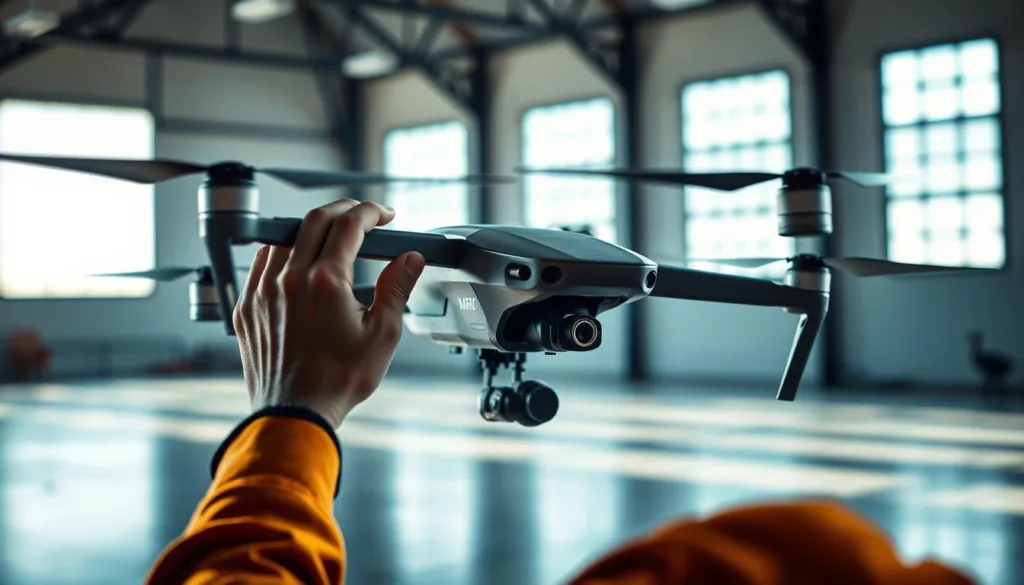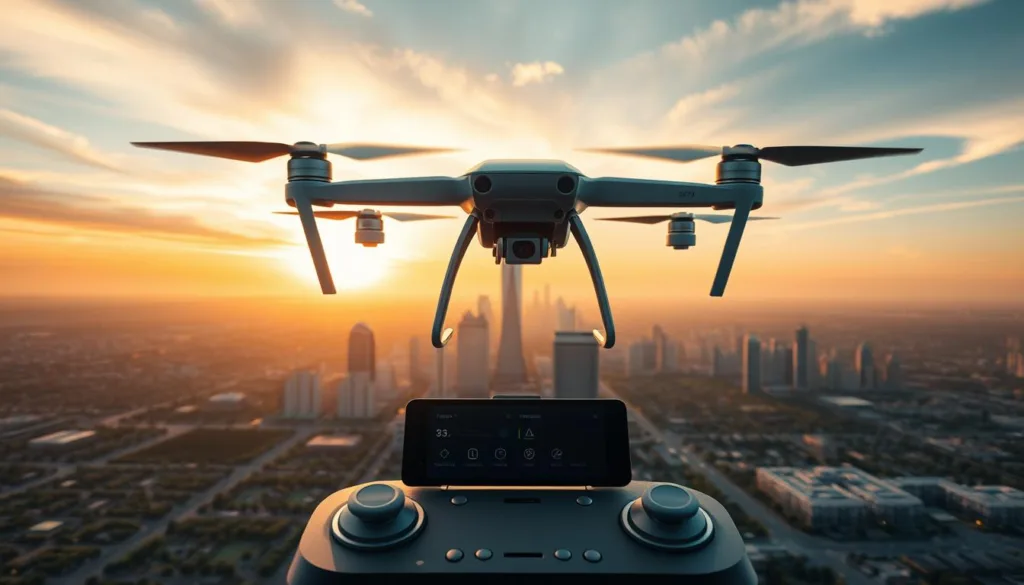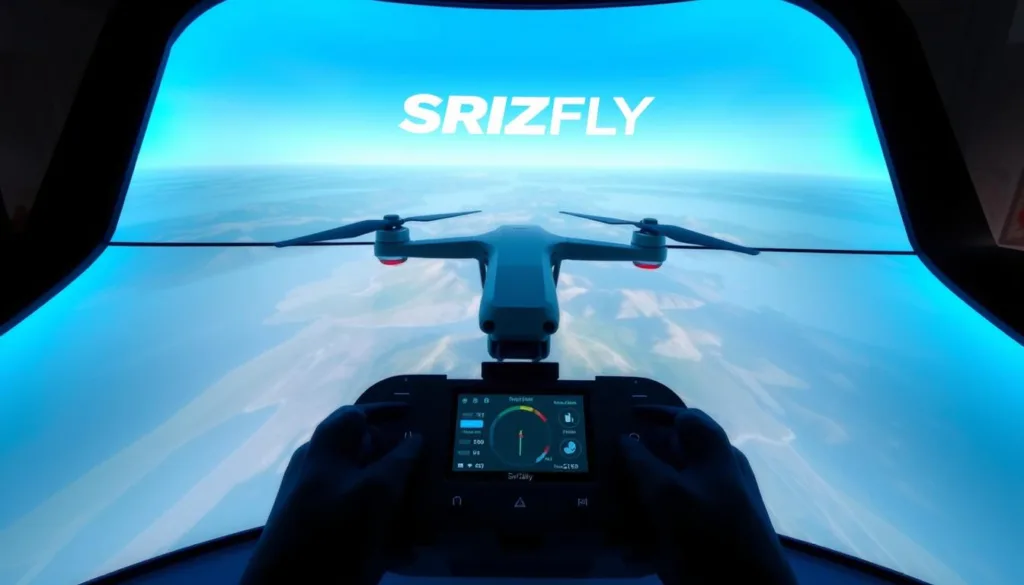Mastering drone piloting just got safer and smarter. Imagine practicing complex maneuvers without risking your equipment. Modern flight training platforms now offer lifelike scenarios that mimic real-world challenges, from gusty winds to tight spaces.
These tools work seamlessly with popular drone models, including the Mavic, Phantom, and Inspire series. Whether you’re a hobbyist or energy sector professional, customized modules adapt to your needs. A recent partnership ensures ongoing updates and compatibility with accessories, making it future-proof for evolving technology.
Free trials let newcomers test the waters, while enterprise packages provide advanced analytics. Users gain confidence through repeated practice in controlled environments—no repair bills or lost drones. It’s like having a virtual co-pilot that never gets tired.
Key Takeaways
- Compatible with major drone models like Mavic and Phantom series
- Official partnership guarantees continuous software support
- Tailored training modules for different skill levels
- Risk-free environment prevents costly accidents
- Cost-effective alternative to physical training sessions
Introduction to the DJI RC Simulator
A new era of drone training eliminates traditional risks. Advanced simulation technology bridges the gap between theory and real-world flying, offering lifelike physics and dynamic weather effects. This platform turns your living room into a virtual airfield where every decision matters—but without consequences.
Overview and Benefits of Drone Simulation
The DJI Flight Simulator replicates wind resistance, battery drain, and camera angles with startling accuracy. Practice emergency landings or navigate tight urban spaces—all while building muscle memory. One user noted, “It feels like flying, just without the panic.”
This training environment reduces costly mistakes. Pilots master complex maneuvers like orbit patterns or elevation changes before touching physical equipment. Repeated practice sessions create instinctive reactions to real challenges.
Who Can Benefit from This Training Tool
Novices gain confidence through guided lessons, while professionals test new flight paths risk-free. Surveyors, filmmakers, and rescue teams all use simulations to refine techniques. Even hobbyists enjoy experimenting with aerial photography angles.
The system adapts to individual learning speeds. Whether you prefer structured courses or freestyle exploration, it grows with your skills. Schools and corporations increasingly adopt these tools for standardized training programs.
Getting Started with the Simulator Setup
Transform your computer into a flight academy with minimal effort. Before soaring through virtual skies, proper preparation ensures your training matches real-world precision. Let’s break down what you’ll need and how to fine-tune your setup.
System Requirements and Software Installation
Your machine needs muscle to handle lifelike physics and weather effects. The base setup requires a Windows 10 64-bit system with at least a G4560 processor and GTX 1050 Ti graphics card. Pair this with 16GB RAM and 80GB of free HDD space for basic operation.
Serious trainees should aim higher. An i7-7700 CPU, GTX 1080 Ti GPU, and 32GB RAM on an SSD deliver buttery-smooth performance. One pilot shared, “Upgrading my rig made obstacle courses feel like child’s play.”
Download the software from official sources and run the installer. Keep Windows updated and refresh graphics drivers to avoid hiccups. The setup wizard guides you through permissions and storage locations in minutes.
Initial Configuration and Calibration Steps
First launches demand precision tuning. Connect your controller and map its buttons through the intuitive interface. Adjust display settings to match your monitor’s native resolution for crisp visuals.
Calibration isn’t just suggested—it’s essential. The software walks you through stick sensitivity adjustments and throttle response tests. Proper alignment here makes the difference between robotic movements and fluid, natural flight patterns.
Spend time testing camera angles and control schemes. These personalized tweaks create a training environment that mirrors your actual gear, building muscle memory that translates directly to field operations.
Step-by-Step Guide to Connecting Your DJI RC Controller
Your training starts with the right handshake between controller and software. Proper setup ensures every stick movement translates perfectly to the virtual sky. Let’s make your physical gear talk to the digital world.
Ensuring Compatibility and Preparing Your Device
First, check if your gear makes the cut. Supported models include Phantom 4 series, Mavic Air, and Matrice units. Newer devices like the Smart Controller often work best. One pilot noted, “My Inspire 1 connected faster than my Bluetooth headphones.”
Charge your controller fully before starting. Install the latest firmware through the manufacturer’s app. Windows users should download drivers from official sources—third-party software can cause hiccups. The setup wizard automatically detects most modern devices.
Troubleshooting Common Connection Issues
If your computer ignores the controller, try different USB ports. Some older ports lack the power for stable links. Update graphics drivers and restart both devices—this fixes 80% of recognition problems.
Calibration errors usually mean sticky joysticks or outdated software. Clean your controller’s gimbals with compressed air. For persistent issues, reinstall the simulator while keeping your settings file intact. Remember: proper preparation prevents 90% of connection headaches.
Mastering Basic Flight Control Techniques
Every expert pilot began by decoding their aircraft’s silent language. Four core commands – throttle, yaw, pitch, and roll – form the vocabulary of precise aerial navigation. This training platform lets you converse fluently with your craft long before actual liftoff.

Understanding Flight Dynamics and Controls
Throttle acts as your vertical elevator. Push up gently to climb, ease back to descend. Yaw spins your view like a compass needle, perfect for scanning landscapes. Pitch leans the nose forward for momentum, while roll slides you sideways through tight spaces.
Aerodynamic forces constantly test your adjustments. One trainee remarked, “Learning how wind pushes against the props changed my entire approach.” The system mimics real-world physics, making every input affect stability and responsiveness.
Practicing Takeoff, Hovering, and Landing
Start with pre-flight checks – virtual props spin just like real ones. Apply throttle gradually until the craft floats at eye level. Hold that hover for 30 seconds while fighting tiny drifts – it’s harder than it looks!
Landings demand feather-light control. Practice cutting power at different heights until touchdowns feel like settling onto cotton. Emergency drills teach quick thinking when batteries dip below 10% in mid-air scenarios.
Advanced Flight Techniques and Simulation Scenarios
Professional pilots know true skill emerges when skies turn hostile. Modern training platforms push users beyond basic controls with scenarios that test decision-making under pressure. These simulations transform theoretical knowledge into instinctive reactions through repetitive, high-stakes practice.
Executing Complex Maneuvers and Emergency Procedures
Master precision flying by threading virtual aircraft through moving obstacles. One trainee shared, “Practicing figure-eight patterns around virtual pylons made real-world inspections effortless.” Emergency drills simulate motor failures and sudden battery drops, teaching quick recovery techniques.
Advanced modules include aerial choreography for cinematic shots. Operators learn to maintain perfect framing while navigating elevation changes. These skills prove invaluable for industrial inspections and search missions.
Simulating Real-World Weather and Terrain Challenges
Gusts of 35 mph? Sideways rain? The system replicates atmospheric conditions with startling accuracy. Pilots develop strategies to counteract wind shear while maintaining camera stability. Mountainous terrains test altitude management, while urban grids demand split-second obstacle avoidance.
Seasoned users report logging over 500,000 virtual feet during extended sessions. This intensive practice builds muscle memory for long-duration flights. Dynamic scenarios adjust difficulty based on performance, ensuring continuous skill growth without plateaus.
Customizing Your Training Environment for Optimal Performance
The key to expert piloting lies in crafting scenarios that mirror real challenges. Modern training platforms let you shape every aspect of practice sessions. From stormy skies to complex urban layouts, these tools adapt to your learning needs.

Adjusting Simulation Settings for Personalized Training
Dial in specific weather patterns like morning fog or afternoon thunderstorms. Change lighting conditions to practice sunset photography or midnight rescue drills. Five camera angles let you view maneuvers from drone-level, operator perspective, or bird’s-eye view.
Choose between three assistance modes: P-mode stabilizes newcomers, A-mode introduces manual elements, and S-mode removes all safeguards. One surveyor noted, “Practicing in hurricane winds prepared me for coastal inspections.” Terrain customization adds mountains, forests, or industrial sites to your virtual playground.
Optimizing Controller Settings and Flight Modes
Fine-tune stick sensitivity for smoother camera pans or quicker obstacle dodges. Remap buttons to match your muscle memory from field operations. Adjust throttle curves until ascents feel as natural as breathing.
Create scenarios targeting specific skills—like power line inspections or cinematic orbit shots. Save favorite configurations for repeat practice or share them with teammates. This flexibility transforms generic drills into targeted skill-building sessions that accelerate mastery.
Exploring dji rc simulator Features and Best Practices
Flight training evolves when every virtual gust feels real. Modern systems transform practice sessions through precision tools that mirror actual operations. These platforms go beyond basic controls to offer measurable growth opportunities.
Key Features that Enhance Simulator Accuracy
The training environment reacts like nature itself. Dynamic wind patterns push against virtual drones while sunlight angles shift during golden hour practice. Flight physics replicate battery drain rates and motor stress levels observed in field tests.
One cinematography student shared, “Practicing sunset shots with changing shadows helped me nail a client’s tight deadline.” The system adjusts terrain textures and obstacle density based on selected locations, from desert canyons to urban high-rises.
Utilizing Data and Performance Metrics
Real-time dashboards display crucial flight data during exercises. Pilots monitor altitude drift, signal strength, and power consumption while executing maneuvers. Post-session reports break down reaction times and stabilization errors.
Detailed logs track progress across multiple scenarios. Users compare hover stability percentages or emergency landing success rates between sessions. This feedback loop helps focus practice on specific weak points like crosswind landings or low-light navigation.
Effective training combines these tools with smart habits. Calibrate controllers weekly and match virtual weather to upcoming field conditions. Review heat maps showing frequent crash zones to anticipate real-world risks. These strategies turn simulated flights into career-building experiences.
Essential Tips for Effective Drone Training
Sharpening your aerial skills requires smart practice habits, not just endless repetition. Whether preparing for commercial inspections or creative projects, focused training builds confidence faster than random trial-and-error flights.
Maximizing Your Training Efficiency
Start each session with clear goals. Focus on one skill like precise hovering or wind compensation. Short, daily drills often work better than marathon weekend sessions.
Review performance metrics after every flight. Look for patterns in stabilization errors or battery management. One cinematographer noted, “Tracking my altitude deviations cut crash rates by 40%.”
Mix up flight scenarios to avoid plateauing. Alternate between stormy weather drills and tight-space navigation. This variety builds adaptable muscle memory that translates to real-world challenges.
End with five minutes of freestyle flying. Unstructured practice helps integrate new skills while keeping training enjoyable. Remember: consistency turns virtual progress into field mastery.
FAQ
What devices work with the DJI RC Simulator?
The software supports popular remote controllers like the Smart Controller and compatible models from the Mavic, Inspire, and Phantom series. Check system requirements for optimal performance on Windows PCs or specific tablets.
Do I need prior experience to use this training tool?
No! It’s designed for all skill levels. Beginners learn basics like takeoff and hovering, while pros practice advanced maneuvers or emergency protocols in customizable scenarios.
Can I simulate flying in harsh weather?
Yes! Adjust settings to mimic wind, rain, or low-light conditions. This helps build confidence for real-world challenges without risking your equipment.
How do I fix connection issues with my controller?
Ensure firmware is updated, cables are secure, and Bluetooth/USB settings match the software’s guidelines. Restart both devices if pairing fails initially.
Does the simulator track progress?
Absolutely. Metrics like flight stability, response time, and landing accuracy are logged. Review these to identify areas for improvement.
What’s the benefit of practicing emergency procedures?
Simulating motor failures or signal loss builds muscle memory. You’ll react faster during actual flights, reducing crash risks and boosting safety.
Can I customize terrain layouts?
Yes. Modify elevation, add obstacles, or replicate urban environments to test navigation skills. Tailor scenarios to match your typical flying locations.
Are there tutorials for mastering complex maneuvers?
The software includes guided lessons for orbits, waypoint navigation, and precision landings. Follow step-by-step demos before trying solo.



